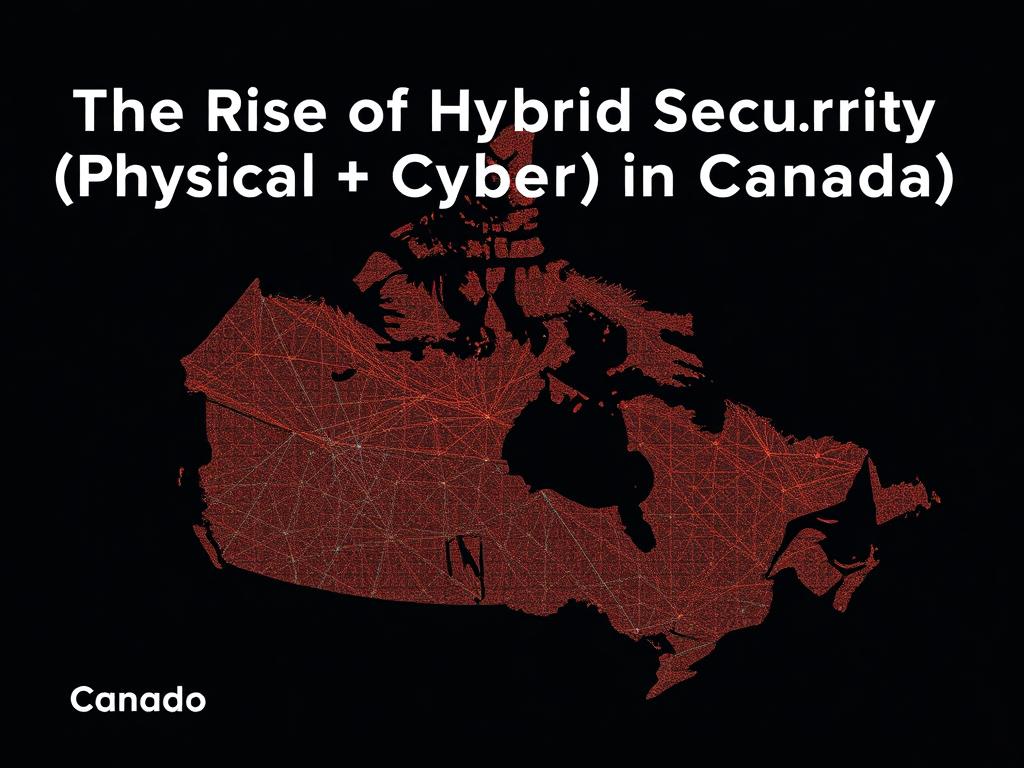In today’s ever-evolving threat landscape, securing assets and information requires more than just traditional methods. Canada, like many other technologically advanced countries, is witnessing a significant shift towards hybrid security—a strategic integration of physical and cyber security measures. This approach acknowledges that physical and digital worlds are no longer separate entities; they interconnect and influence each other profoundly. Whether it’s safeguarding a high-security facility or protecting a sprawling corporate network, hybrid security is becoming the norm rather than the exception. This article takes a deep dive into why hybrid security is critical in Canada, how it functions, and what businesses and government entities need to know to thrive in this environment.
Understanding Hybrid Security: A New Paradigm

Hybrid security merges physical security systems—like surveillance cameras, access control, and on-site personnel—with cybersecurity protocols, such as firewalls, intrusion detection systems, and data encryption. The goal is to create a resilient defense mechanism that addresses vulnerabilities from multiple angles. In Canada, the rise of hybrid security reflects a broader realization: cyber threats can have physical consequences, and physical security breaches can expose sensitive data.
For example, unauthorized access to a physical data center can lead to cyber theft, while a ransomware attack can disable physical systems like security cameras or HVAC controls. To prevent such overlaps, organizations in Canada are investing in technology and strategies that blend these once-distinct domains.
Why Canada is Embracing Hybrid Security
Several unique factors drive Canada’s adoption of hybrid security practices. First, the country’s vast infrastructure—from energy grids to transportation networks—is critical not only to the Canadian economy but also to North American security. The interconnected nature of this infrastructure means that attacks leveraging physical and cyber vulnerabilities can have catastrophic impacts.
Second, regulatory environments are evolving. Canadian laws around privacy, data protection, and industrial security increasingly require organizations to adopt comprehensive security frameworks. Compliance with government standards such as the Canadian Cyber Security Strategy or industry-specific mandates in banking and healthcare demands a hybrid approach.
Third, Canada’s growing technological landscape—from smart cities to the Internet of Things (IoT)—creates an expanded attack surface. Wireless sensor networks controlling traffic lights or monitoring environmental conditions need protection in both physical and cyber realms to ensure public safety and operational continuity.
Core Components of Hybrid Security in Canada
To understand how hybrid security is realized, it’s important to look at its components. Successful implementation involves a mix of technology, processes, and people working in concert.
Physical Security Technologies
Physical security is the foundation. Common technologies include:
- Access control systems (biometrics, key cards)
- Surveillance cameras with video analytics
- Intrusion detection sensors (motion, glass break)
- Security personnel patrols and guard stations
- Perimeter barriers like fences and bollards
In Canada, many organizations enhance these systems with smart integrations, such as linking physical alarms with cybersecurity monitoring platforms, enabling rapid detection and response.
Cybersecurity Measures
On the digital front, the tools often comprise:
- Network firewalls and endpoint protection
- Multi-factor authentication (MFA)
- Encryption of sensitive data
- Security information and event management (SIEM) systems
- Incident response and threat intelligence teams
These cybersecurity protocols help defend against hacking attempts, malware, phishing, and insider threats. Within a hybrid solution, they are interconnected with physical security alerts, yielding a more holistic situational awareness.
Integration Technologies
The linchpin of hybrid security is integration. Without it, physical and cyber defenses operate in silos, leaving gaps. Integration technologies encompass:
| Technology | Description | Canadian Application |
|---|---|---|
| Unified Security Platforms | Combine video surveillance, access controls, and security alerts in one dashboard | Used by Canadian airports and critical infrastructure sites for real-time monitoring |
| IoT Security Solutions | Manage and monitor connected devices for vulnerabilities | Smart city projects in Toronto and Vancouver implement these systems |
| AI and Machine Learning | Analyze behavioral patterns and identify anomalies across physical and digital systems | Financial institutions in Canada utilize AI-driven risk detection |
This integration ensures that when a cyber threat triggers an alert, physical security teams are immediately aware, and vice versa.
Risks Mitigated by Hybrid Security in Canada
Canada’s adoption of hybrid security addresses several critical risks that can cause major disruption:
Insider Threats
One of the most challenging security risks involves insiders who have legitimate access but may unintentionally or deliberately cause harm. Hybrid systems can monitor suspicious physical movements combined with unusual network behavior, increasing the chances of detecting insider threats early.
Supply Chain Vulnerabilities
Modern Canadian businesses depend heavily on global supply chains. Both physical shipment tampering and cyber attacks—like ransomware on logistics software—pose threats. Hybrid security measures enhance visibility and control over each stage, from warehouses to transportation.
Critical Infrastructure Attacks
Power grids, water supply systems, and telecommunications are targets for sophisticated attackers who mix physical sabotage with cyber intrusions. The Canadian government’s prioritization of hybrid security in these sectors is crucial for national resilience and public safety.
Data Breaches Triggered by Physical Access
Many data breaches start with physical access that enables attackers to plug in rogue devices or steal hardware. Without integrated physical-cyber defenses, such threats are harder to detect and stop.
Implementation Challenges in Canadian Organizations
While the hybrid security model offers robust protections, implementing it is not without challenges.
Organizational Silos
In many Canadian companies, physical security teams and cybersecurity personnel operate separately, leading to fragmented communication and inconsistent security postures. Bridging these silos requires cultural shifts and leadership buy-in.
Budget Constraints
Hybrid security infrastructure demands investment in technology and training. Smaller businesses in Canada may find budgetary restrictions challenging, even though they face similar threats as large enterprises.
Complex Regulatory Landscape
Navigating Canada’s overlapping federal, provincial, and industry-specific regulations can be tough. Understanding how laws like PIPEDA (Personal Information Protection and Electronic Documents Act) intersect with security practices is essential.
Talent Shortage
There is a notable shortage of security professionals trained in both physical and cybersecurity disciplines. Canadian educational institutions and industry groups are increasingly promoting hybrid skill sets to address this gap.
Case Studies: Hybrid Security Success Stories in Canada
Canada’s leading organizations are already embracing hybrid security with impressive results. Here are a few illustrative examples:
| Organization | Industry | Hybrid Security Strategy | Outcome |
|---|---|---|---|
| Toronto Pearson International Airport | Transportation | Integrated digital surveillance with controlled access to sensitive operational zones, real-time threat intelligence sharing | Reduced unauthorized access incidents by 40%, improved incident response time |
| Hydro-Québec | Energy | Deployed AI-based monitoring combining physical sensor data with network logs to detect disruptions | Enabled early detection of cyber-physical intrusion attempts, improved grid resilience |
| National Bank of Canada | Financial Services | Unified security operations center monitoring physical branches and digital assets collectively | Decreased fraud incidents, enhanced compliance with security regulations |
These examples illustrate the tangible benefits Canada’s organizations are achieving by embracing the hybrid security approach.
Best Practices for Adopting Hybrid Security in Canada
For Canadian organizations looking to enhance their security posture, several best practices can smooth the path to successful hybrid security implementation.
Conduct Thorough Risk Assessments
Evaluate both physical and cyber risks systematically. Understand how they intersect and prioritize vulnerabilities that could be exploited through hybrid attack vectors.
Foster Cross-Department Collaboration
Encourage joint training, combined incident response plans, and shared communication channels between physical security and cybersecurity teams.
Invest in Integrated Technologies
Choose platforms that unify management of physical and cyber assets, making it easier to correlate events and mobilize responses promptly.
Compliance and Continuous Improvement
Stay updated on Canadian laws and industry standards, regularly audit hybrid security measures, and adapt to emerging threats through continuous improvement cycles.
Employee Awareness and Training
Employees are often the weakest security links. Hybrid security demands awareness across the board, from recognizing phishing attempts to reporting suspicious physical activities.
The Future of Hybrid Security in Canada

Looking ahead, hybrid security will likely evolve alongside technology trends such as artificial intelligence, machine learning, and 5G connectivity. Canadian organizations will benefit from increasingly sophisticated analytics that can predict and prevent complex threats before they materialize.
Moreover, as smart city initiatives take root in urban centers across Canada, hybrid security will become a foundational element of public infrastructure safety. Governments will also enhance collaboration with private sectors to safeguard critical systems.
Canada’s hybrid security trajectory is a reflection of the global movement towards converged security strategies. It’s an exciting era where physical barriers and digital firewalls work hand in hand, defending the nation against a spectrum of risks.
Conclusion

The rise of hybrid security in Canada marks a pivotal moment in how the country approaches protection—recognizing that physical and cyber threats are intertwined and demand unified solutions. Through integrating advanced technologies, fostering collaboration, and addressing challenges head-on, Canadian organizations can create resilient defenses that safeguard people, data, and infrastructure alike. This shift is not just a technical upgrade but a strategic necessity in an increasingly complex security environment. As threats continue to evolve, so too must Canada’s hybrid security landscape, ensuring safety and trust in every facet of modern life.